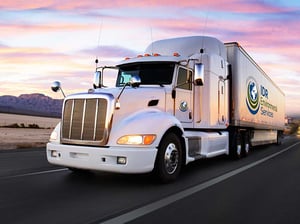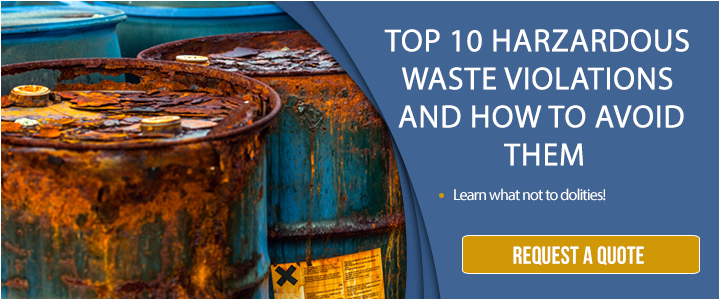When managing hazardous waste, the smallest oversight can lead to catastrophic consequences.
This is not a dramatic scenario, but a real risk faced by many facilities that handle flammable materials. Flammable bins play an important role in preventing explosions and spills, and creating a safe work environment for your employees.
However, selecting the correct flammable bins is just one step in the process to keep your facility compliant and safe. Once these bins leave your facility, you must ensure your efforts to mitigate any risks continue. Here’s why choosing the right transporter and facility to accept your waste is key.
Flammable Bins: Your First Line of Defense
Flammable bins are specially designed containers used for the disposal of materials that can easily ignite. These bins are typically constructed from fire-resistant materials and feature secure lids. Lids prevent the escape of vapors, which could contribute to accidental ignition.
are typically constructed from fire-resistant materials and feature secure lids. Lids prevent the escape of vapors, which could contribute to accidental ignition.
One of the primary purposes of flammable bins is to prevent fires. By securely containing flammable materials, these bins minimize the risk of accidental ignition. This is particularly crucial in environments where flammable materials are frequently used, including laboratories, manufacturing facilities and workshops.
Agencies like the Occupational Safety and Health Administration (OSHA), the Environmental Protection Agency (EPA) and the U.S. Department of Transportation (DOT) require facilities to use the proper flammable bins for storage and transportation.
Not doing so can lead to environmental contamination. For instance, if these materials are discarded in regular trash bins, they can leach into the soil and water, causing long-term damage to ecosystems. Flammable bins help contain and isolate hazardous waste, facilitating safe disposal and reducing environmental impact.
Flammable Bin Regulations To Know
One of the most important things to know about these storage containers is that which flammable bin you use depends on the amount of substance and type of waste.
OSHA classifies flammable liquids into four categories based on their flashpoints and boiling points. Knowing these categories will help you follow the correct storage requirements for your flammable bins.
- Category 1: Includes liquids having flashpoints below 73.4 °F (23 °C) and having a boiling point at or below 95 °F (35 °C)
- Category 2: Includes liquids having flashpoints below 73.4 °F (23 °C) and having a boiling point above 95 °F (35 °C).
- Category 3: Includes liquids having flashpoints at or above 73.4 °F (23 °C) and at or below 140 °F (60 °C). When a Category 3 liquid with a flashpoint at or above 100 °F (37.8 °C) is heated for use to within 30 °F (16.7 °C) of its flashpoint, it shall be handled in accordance with the requirements for a Category 3 liquid with a flashpoint below 100 °F (37.8 °C).
- Category 4: Includes liquids having flashpoints above 140 °F (60 °C) and at or below 199.4 °F (93 °C). When a Category 4 flammable liquid is heated for use to within 30 °F (16.7 °C) of its flashpoint, it shall be handled in accordance with the requirements for a Category 3 liquid with a flashpoint at or above 100 °F (37.8 °C). 5.
According to OSHA, when a liquid with a flashpoint greater than 199.4 °F (93 °C) is heated for use to within 30 °F (16.7 °C) of its flashpoint, it shall be handled according to the requirements for a Category 4 flammable liquid.
With this information about flammable liquid categories, you can now determine which bins are appropriate for the flammable liquids you use or the waste you generate.
Glass/approved plastic:
- Category 1: 1 pint
- Category 2: 1 quart
- Category 3: 1 gallon
- Category 4: 1 gallon
Metal (other than DOT drums):
- Category 1: 1 gallon
- Category 2: 5 gallons
- Category 3: 5 gallons
- Category 4: 5 gallons
Safety cans:
- Category 1: 2 gallons
- Category 2: 5 gallons
- Category 3: 5 gallons
- Category 4: 5 gallons
Metal drums (DOT spec.):
- Category 1: 60 gallons
- Category 2: 60 gallons
- Category 3: 60 gallons
- Category 4: 60 gallons
Approved portable tanks:
- Category 1: 660 gallons
- Category 2: 660 gallons
- Category 3: 660 gallons
- Category 4: 660 gallons
Other key requirements for flammable bins include:
- Construction: Flammable bins should be made of fire-resistant materials and designed to contain flammable vapors securely.
- Labeling: Bins must be clearly labeled to indicate they are for flammable materials, reducing the risk of improper disposal.
- Ventilation: Proper ventilation is required to prevent the buildup of flammable vapors within the bins.
- Lid Security: Bins must have secure lids to prevent accidental spills and the escape of vapors.
- Maintenance: Regular inspections and maintenance are necessary to ensure bins remain in good condition and effective for their intended use.
By adhering to these regulations and standards, organizations can significantly reduce the risk of fires and ensure compliance with legal requirements.
Flammable Bins And Transportation
The transportation of hazardous waste is a critical phase in its lifecycle, where the risks of accidents and environmental contamination are heightened.
contamination are heightened.
Proper bins are specifically designed to contain hazardous substances securely and prevent leaks, spills and the release of toxic vapors. Using the correct bins minimizes the potential for accidents during transit, protecting not only the transport personnel but also the general public and the environment.
Flammable bins, in particular, play a vital role in safely transporting ignitable materials like solvent waste. These bins are constructed from fire-resistant materials and equipped with secure lids to prevent accidental ignition and contain flammable vapors.
As a facility that generates flammable waste, you’re responsible for ensuring that waste is disposed of properly, even after it leaves your hands. This law is known as cradle to grave. Collaborating with a certified hazardous waste disposal transporter or treatment, storage and disposal facility (TSDF) to transport your waste safely is critical.
A certified fleet of vehicles and trucks incorporate secure elements that include:
- Operators and drivers trained for emergencies
- Operators and drivers with the correct credentials for transporting your particular type of waste
- Routine maintenance on trucks to ensure top performance and safety
- Permits and licenses to ensure legal transit
- Proper waste manifest and documentation completed throughout the route
- Insurance and bonds on units and workers
- Secure locking systems to prevent unauthorized access
Selecting a hazardous waste disposal company with a strong focus on transportation safety is an important step in the journey your waste takes. While your focus may be on securing flammable bins, ensuring those bins are equipped for hazardous waste disposal will help mitigate risks and maintain a safe, compliant operation.


Comment